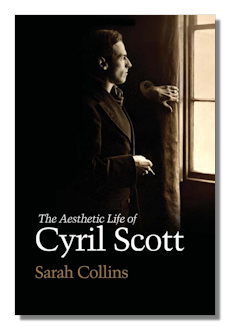
The Internet's Premier Classical Music Source
Related Links
-
Introduction
Acoustics
Ballet
Biographies
Chamber Music
Composers & Composition
Conducting
Criticism & Commentary
Discographies & CD Guides
Fiction
History
Humor
Illustrations & Photos
Instrumental
Lieder
Music Appreciation
Music Education
Music Industry
Music and the Mind
Opera
Orchestration
Reference Works
Scores
Thematic Indices
Theory & Analysis
Vocal Technique
Search Amazon
Recommended Links
Site News
 Book Review
Book Review
The Aesthetic Life of Cyril Scott

Sarah Collins
The Boydell Press, 2013. Xxxi, 248 pages
Illustrations, Select Bibliography, Index
Recyclable paper from sustainable forests
ISBN-10: 1843838079
ISBN-13: 978-1843838074
In her Epilogue to this scholarly account of Cyril Scott, Sarah Collins mentions the "narrow and singular construction of Scott as a composer, with 'other interests…'" This, following her earlier statement that "in the course of his ninety-one years, Scott fashioned a career as a composer, a poet, a writer of occult fiction, a philosopher and an expert in alternative medicine…," Collins places Scott in the context of cultural and intellectual currents early in the twentieth century. In the interests of full disclosure, I studied those movements – to a degree – with Professor George L. Mosse at the University of Wisconsin many years ago; his description of the homoerotic circle of the important poet Stefan George is still vivid in my mind, but I have to say that Collins' account of George is very likely more accurate than Mosse's, indicating that George made sexual advances on Scott, who declined them. Mosse emphatically described George's loves as purely Platonic.
I will be frank about my own view of Cyril Scott, whose final autobiography I read following my initial acquaintance with some of his music. His most worthwhile legacy was his music. The rest is of historical interest to specialists, I think.
But Collins' title was well chosen. Scott was an aesthete from his youth, initially drawn strongly to the Pre-Raphaelites and Imagist poetry, including that of Stefan George, whom he knew in Frankfurt, where he studied when very young. He translated George's poetry into English. (In Frankfurt he also began his lifelong friendship with Percy Granger, who was so good a friend as to assist Scott financially in times of need.) Scott wished his manners and life to reflect his aesthetic tastes – to the extent of being a cultural snob when he was young. Happily, he shed much of his snobbery later.
Collins' book is in two main sections. Part I focuses on Scott's biography, with emphasis on his occultist beliefs. He followed the directions of a "Master" identified mainly as K.H., or Koot Hoomi. Among other things – shockingly to me – he married a writer named Rose Allatini at the behest of his Master. The fact of the marriage is abruptly introduced in Collins' text. An anonymous fictional account by Scott suggests that neither Cyril nor Rose were especially attracted to one another. A photo of Rose with their two children shows her as a lovely woman. Scott was persuaded to believe that his daughter was the reincarnation of a dead Swami. Scott and Rose stayed together for many years, until Rose left to live alone. Scott took up with a woman named Marjorie Hartston, variously identified as Scott's partner and as Marjorie Hartston-Scott. Collins tells us next to nothing about Scott's personal life with either woman, especially Rose.
Those interested simply Scott's music can go directly to section II, chapters 5-7. There Collins gives an account of Scott's musical aesthetics, including (in Chapter 5) his view of music's social effect. Chapter 6 shows Scott as a Romantic, stressing the importance of stylistic originality and innovation. He liked Wagner; he was attached to beauty and did not like the Futurists. He believed that musical change precedes social change. Collins says that Scott "decried artistic manifestoes, yet he actively identified himself with the Pre-Raphaelite cause. His conception of aesthetic beauty was thus coloured by a fundamental idealism, misconstrued as an objective spiritual benchmark" (166). Scott saw three stages to the reception of an artwork, ranging from initial unpleasant reactions through neutral feelings to distinct pleasure. Collins suggests this might have been a "convenient rationalism for his own later obscurity." His early works were considered avant-garde; later he was seen as old hat. In 1917 he published a book The Philosophy of Modernism. At one point Scott maintained that music expresses nothing but itself but Collins concludes that Scott's views on this subject were "often unclear and sometimes contradictory." (175).
Collins' substantial Chapter 7, "Theory and Practice," includes professional level musical analysis, with musical examples (scores.) Those with a strong interest in Scott's music will want to study this chapter. They will also want to hear, among other music, the excellent recent recordings on Chandos of performances of Scott's symphonies, concertos and other orchestral music conducted by Martyn Brabbins, and with informative notes. Surprisingly, Scott's appealing Clarinet Concerto does not appear to be currently available on disc.
As usual with Boydell's publications, this book is handsomely produced, with heavy bright white paper and sturdy, if not sewn, binding. The many illustrations are clear.
Copyright © 2016, R. James Tobin


















